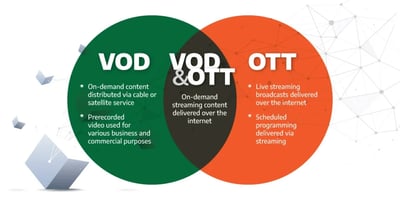1. A Data Tsunami No One Saw Coming 2. The Foundations: How a Video CDN Really Works 3. Why Latency...
What is CDN Latency and How Can It Be Reduced?
Imagine this: You're on the brink of launching your new online platform. Everything is set. Your design is sleek, the user interface intuitive, but there's one lurking beast waiting to sabotage it all—latency. Slow load times, buffering videos, and scattered downloads can rapidly turn your dream launch into a consumer nightmare. But fear not! In the labyrinth of digital performance, understanding and minimizing Content Delivery Network (CDN) latency can be your guiding light.
What is CDN Latency?
Latency, in essence, is the delay or time lag in data transmission. In the context of CDNs, it refers to the time taken for a data packet to travel from a server to an end user. Latency can be visualized as the momentary pause you experience when waiting for a video to buffer or a website to load. This delay is crucial since it directly impacts user experience. Imagine losing potential customers simply because your site takes a couple of extra seconds to load!
Latency is influenced by several factors, including geographical distance between the user and server, the quality of the internet connection, network congestion, and server performance. Typically, the further the data has to travel, the greater the latency.

Factors Contributing to CDN Latency
1. Geographical Distance
The most significant factor contributing to latency is the physical distance between the user and the data source. A user in Asia trying to access a server located in North America will experience higher latency compared to a server located in their region. This is because data packets need to travel through a series of routers and switches, increasing the journey time.
2. Network Congestion
Just like traffic jams on a highway, networks can also get congested, leading to increased latency. During peak usage times, servers and network infrastructure can become overloaded, resulting in slower data transmission.
3. Type of Content
Certain types of content inherently cause more latency. For instance, delivering high-definition video streams or large file downloads can take longer compared to delivering smaller, static files. This is due to the additional data processing and transmission time required for bulkier content.
4. Routing Inefficiencies
Sometimes, the route taken by a data packet isn’t the most efficient. Various hops across servers, routers, and network nodes can add to the total transmission time, much like taking a scenic route instead of the highway. These routing inefficiencies can occur due to outdated infrastructure or network policies.
Strategies to Reduce CDN Latency
1. Edge Servers
Deploying edge servers can dramatically reduce latency by bringing the content closer to the end user. Edge servers are geographically distributed servers that cache copies of content. Instead of making the long trip to the origin server, data can be served from the nearest edge server, slashing the distance and improving load times. Effective use of edge computing can make high-traffic events seamless, ensuring that all users have a smooth experience.
2. Optimized Routing
CDNs that employ intelligent routing techniques can substantially cut down on latency. By constantly analyzing network conditions and dynamically choosing the best path for data packets, intelligent routing ensures that the quickest and most efficient route is always chosen. This minimizes unnecessary hops and delays, similar to using a navigation app to avoid traffic jams in real time.
3. Compression Techniques
Compressing data reduces the size of files, making them quicker to transmit. Modern CDN providers use advanced compression algorithms to shrink images, videos, and other assets without compromising quality. This results in faster load times as smaller packets zip through networks with greater ease. Using formats like WebP for images and Brotli for text files can minimize file sizes significantly, enhancing delivery times.
4. Monitoring and Analytics
Continuous monitoring and analytics can help pinpoint issues in real-time, enabling quick rectifications. CDNs equipped with robust analytics tools provide insights into performance metrics and bottlenecks, allowing for proactive optimizations. Regularly analyzing these data points is akin to continuous health checkups for your network infrastructure, ensuring that everything is running smoothly and efficiently.
5. Load Balancing
Distributing traffic evenly across multiple servers using load balancing reduces the strain on individual servers and ensures consistent performance. Load balancing prevents any single server from becoming a bottleneck, thus maintaining smooth and quick data transmission by optimizing resource usage across the network.
Future Trends in Reducing CDN Latency
As technology evolves, several emerging trends promise further reductions in CDN latency:
1. 5G Integration
The rollout of 5G networks is poised to revolutionize data transmission speeds. With lower latency and higher bandwidth, 5G will enable quicker data delivery and more efficient handling of high-demand content, such as virtual reality and ultra-high-definition video streams. The near-zero latency offered by 5G is expected to create significant enhancements in user experiences globally.
2. AI and Machine Learning
Artificial Intelligence (AI) and Machine Learning (ML) are increasingly being integrated into CDN infrastructures to predict traffic patterns and optimize the routing of data packets. These technologies can foresee potential congestion points and reroute traffic proactively, ensuring smooth and swift data delivery.
3. Blockchain Technology
Blockchain offers promise in enhancing CDN performance by decentralizing data delivery and increasing transparency in data handling. This technology can provide secure, efficient, and transparent ways to manage data transactions, potentially reducing latency through distributed computing models.
Incorporating these cutting-edge technologies not only improves the efficiency of CDNs but also makes them more adaptable to the growing demands of digital content delivery.
Conclusion with a Forward-Looking Perspective
Understanding and minimizing latency is key to delivering excellent user experiences in an era where digital performance directly correlates to business success. From edge servers to AI-driven optimizations, there are multiple strategies available that significantly reduce CDN latency. As innovations like 5G and blockchain continue to develop, the future holds even more potential for enhancing data delivery speeds.
For companies seeking a dependable CDN solution to optimize their digital delivery, BlazingCDN offers robust features and competitive pricing, ensuring a smooth and responsive experience for users worldwide. Check out BlazingCDN’s pricing plans to find the best fit for your needs.
We hope this deep dive into CDN latency has been informative. What strategies have you implemented to reduce latency on your platform? Share your insights and join the conversation below!


